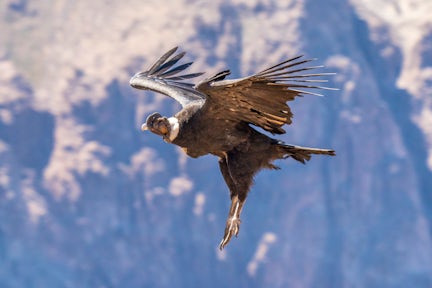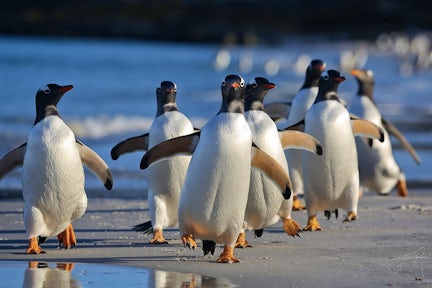Mammals

Explore Patagonia’s diverse mammal species, focusing on the iconic Andean puma, guanacos, and the endangered huemul deer, alongside other wildlife like foxes, armadillos, and …
Discover MoreDeep roots in Patagonia: We are ex-guides, tour leaders, outdoor enthusiasts, & adventurers.
We’ve got our feet on the ground: Impartial advice, a bespoke service, and at no extra cost.
For the ends of the Earth: Sustainability is more than our carbon footprint (but we’re reducing that too).

Patagonia is a birder’s dream, where condors ride thermals, torrent ducks surf rapids, and horned owls haunt the steppe at dusk. The mix of glaciers, forests, and open plains makes every hike or excursion a chance to spot something rare. There are 450+ bird species in total, plus the chance to see 6 types of penguin.
The Andean condor is one of Patagonia’s most iconic birds, with a wingspan of up to 10 feet, making it one of the largest flying birds in the world. These scavengers rely on strong air currents to stay aloft, often soaring for hours without flapping their wings. They are commonly seen in areas with steep cliffs, such as Torres del Paine National Park, where they roost and nest.
For the best chance of spotting a condor, look to the skies in the early morning or late afternoon when they are most active. They can often be seen circling high above valleys, ridgelines, or carcasses. Binoculars can help pick out their distinctive black-and-white plumage and broad, fingered wingtips. Watching from a viewpoint near their nesting sites increases the likelihood of an encounter.

Interesting fact - Condors "ride thermals" by using rising columns of warm air to gain altitude and stay aloft with minimal effort. These thermals form as the sun heats the ground, causing the air above to rise. In Patagonia, strong thermals around cliffs and ridges help them glide effortlessly. To spot one, watch the high skies near rocky outcrops where the air lifts them.
Rachel Clarke Customer Experience Coordinator
In Patagonia, you could see up to 6 species of this diminutive flightless bird:
Magellanic penguins are one of Patagonia’s most charismatic seabirds, nesting in burrows along the windswept coasts of Argentina and Chile. Huge colonies can be found on Magdalena Island in the Strait of Magellan (near Punta Atenas), where thousands of them waddle along the shore or dive into the sea to hunt for fish.
Visiting during breeding season (September–March) offers the best chance to see them up close as they return to their nesting sites and raise their fluffy chicks.

The Humboldt Penguin is primarily found along the coasts of Chile and Peru, with the southernmost populations reaching northern Patagonia. They can occasionally be spotted along the Chile-Argentina border, especially in the Chiloé Archipelago and Magdalena Island, where their range overlaps with that of the Magellanic Penguin.
Humboldt's are uniquely adapted to warm coastal deserts, relying on the cold Humboldt Current for food, nesting in burrows to escape the heat, and using pink facial patches to regulate temperature.

The King Penguin is one of the most striking penguin species around. The only breeding colony in mainland Patagonia is located in Bahía Inútil, Tierra del Fuego, where a small population of around 200 birds can be found. Unlike the Falkland Islands, where visitors can have close encounters with penguins, Parque Pingüino Rey enforces strict viewing guidelines to protect the birds. You'll observe the penguins from designated viewing areas and hides.
One of the most interesting things about King Penguins is their breeding cycle. Their egg incubation period lasts about 54 days, and after hatching, the chicks are cared for by both parents for several months—sometimes as long as 13–16 months—making their parenting duties among the longest in the animal kingdom!

Gentoo Penguins are one of the fastest and most agile penguin species, reaching speeds of 22 miles per hour while swimming. They are easy to spot due to their distinctive bright orange beaks and the white markings on their heads.
They are most commonly found on the Falkland Islands, but you can also spot them on the southernmost coasts of Chile and remote islands near Tierra del Fuego. They nest in colonies on rocky shores and prefer areas where the sea is rich in krill and fish.
Gentoo's are also known for their elaborate courtship displays, where males present pebbles to females as a way of showing their suitability as mates.

The Southern Rockhopper is a small, feisty penguin known for its distinctive spiky yellow crest, red eyes, and bold personality. Unlike other penguins that slide on their bellies, Rockhoppers leap with agility across rugged, rocky coastlines, using their strong legs and sharp claws to navigate cliffs.
Your chances of seeing them are likely to be confined to Isla de los Estados (Staten Island), a remote island east of Tierra del Fuego or at Peninsula Valdés.
They are also remarkable for their long migrations, sometimes swimming hundreds of miles in search of food, making them one of the toughest penguin species in the sub-Antarctic.

The Darwin rhea, also known as the Lesser rhea, is a flightless bird native to the windswept grasslands and scrublands of Patagonia. Unlike its larger cousin, the Greater rhea, it is more compact and well-adapted to rugged, high-altitude terrain, reaching speeds of up to 37 mph (60 km/h) to escape predators like pumas and foxes.
One of its most fascinating traits is its breeding behaviour—males take on the role of incubating eggs and raising the chicks, sometimes caring for clutches laid by multiple females.
You can spot rheas in Patagonia’s vast steppe regions, including Torres del Paine National Park and Peninsula Valdés.

Chilean Flamingo 🦩 (30–70% chance) – This elegant, pale pink flamingo thrives in Patagonia’s high-altitude lakes and coastal lagoons, filtering algae and small crustaceans with its specialised beak. Despite the harsh conditions, large flocks gather in places like Torres del Paine and the Atacama. Their vibrant colour comes from their diet.
Torrent Duck 🦆 (20–40% chance) - A striking black, white, and rust-coloured duck that thrives in fast-flowing rivers. Look for them along the Río de las Vueltas (Los Glaciares) or the Baker River (Aysén), where they skillfully 'surf' rapids by diving underwater to avoid the strongest currents, using their webbed feet to steer and propel themselves through rushing water.
Austral Pygmy Owl 🦉 (15–30% chance) - This tiny but fierce owl can sometimes be spotted in Lenga forests around El Chaltén. Listen for its distinctive, high-pitched call at dawn or dusk. It's a beautiful species.
Ochre-flanked Tapaculo 🐦 (5–20% chance) - A tiny, secretive forest bird that scurries through undergrowth rather than flying. Your best bet is quiet trails in the southern beech forests of Tierra del Fuego or the Aysén region, listening for its rapid, metallic song.
White-throated Caracara 🦅 (5–15% chance) - One of the rarest raptors in Patagonia, this striking black-and-white bird scavenges near carcasses. Occasionally spotted in Patagonia National Park, Torres del Paine and Tierra Del Fuego.
Learn about how our Polar Specialist Colin saw 40+ species in one December day in Tierra del Fuego.
Swoop Patagonia Expert Colin

Flamingo

Torrent Duck

Pygmy Owl

Tapaculo

White-throated Caracara

Explore Patagonia’s diverse mammal species, focusing on the iconic Andean puma, guanacos, and the endangered huemul deer, alongside other wildlife like foxes, armadillos, and …
Discover More.jpg?auto=format,enhance,compress&fit=crop&crop=entropy,faces,focalpoint&w=580&h=300)
This page highlights the incredible marine life along Patagonia’s coast, from whales and dolphins to penguins and sea lions. It showcases the region’s rich biodiversity and the…
Discover More
From elusive cats and soaring condors to waddling penguins, this page offers a look at Patagonia’s diverse animals and the unforgettable encounters awaiting you.
Discover More